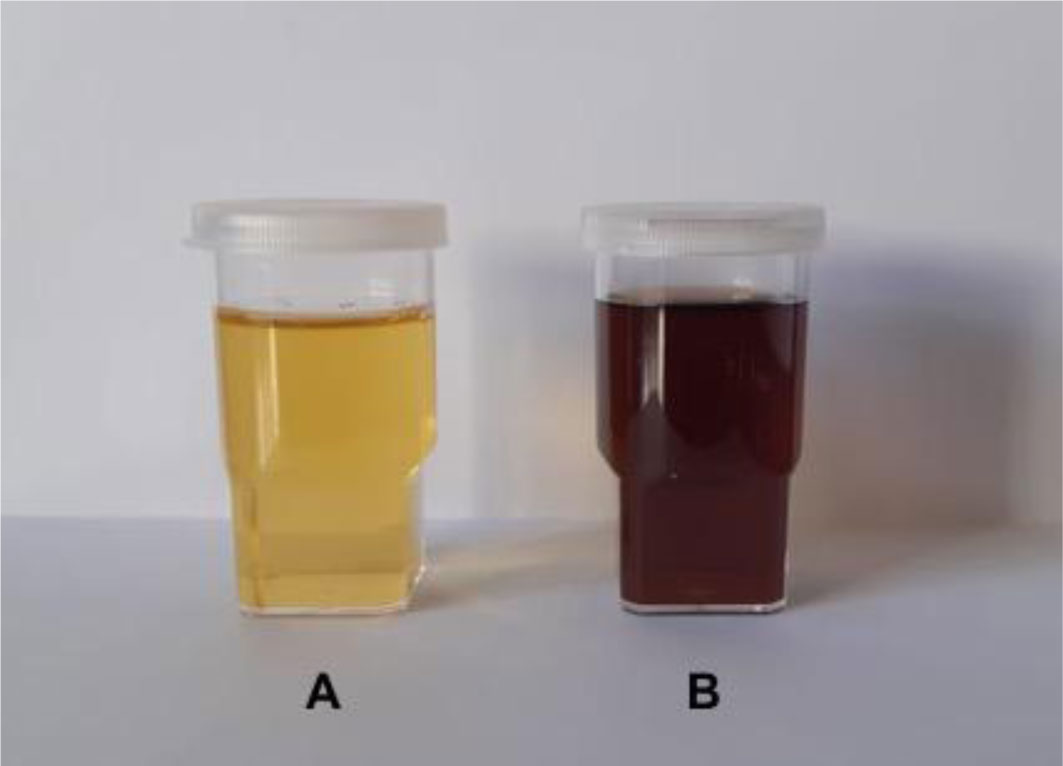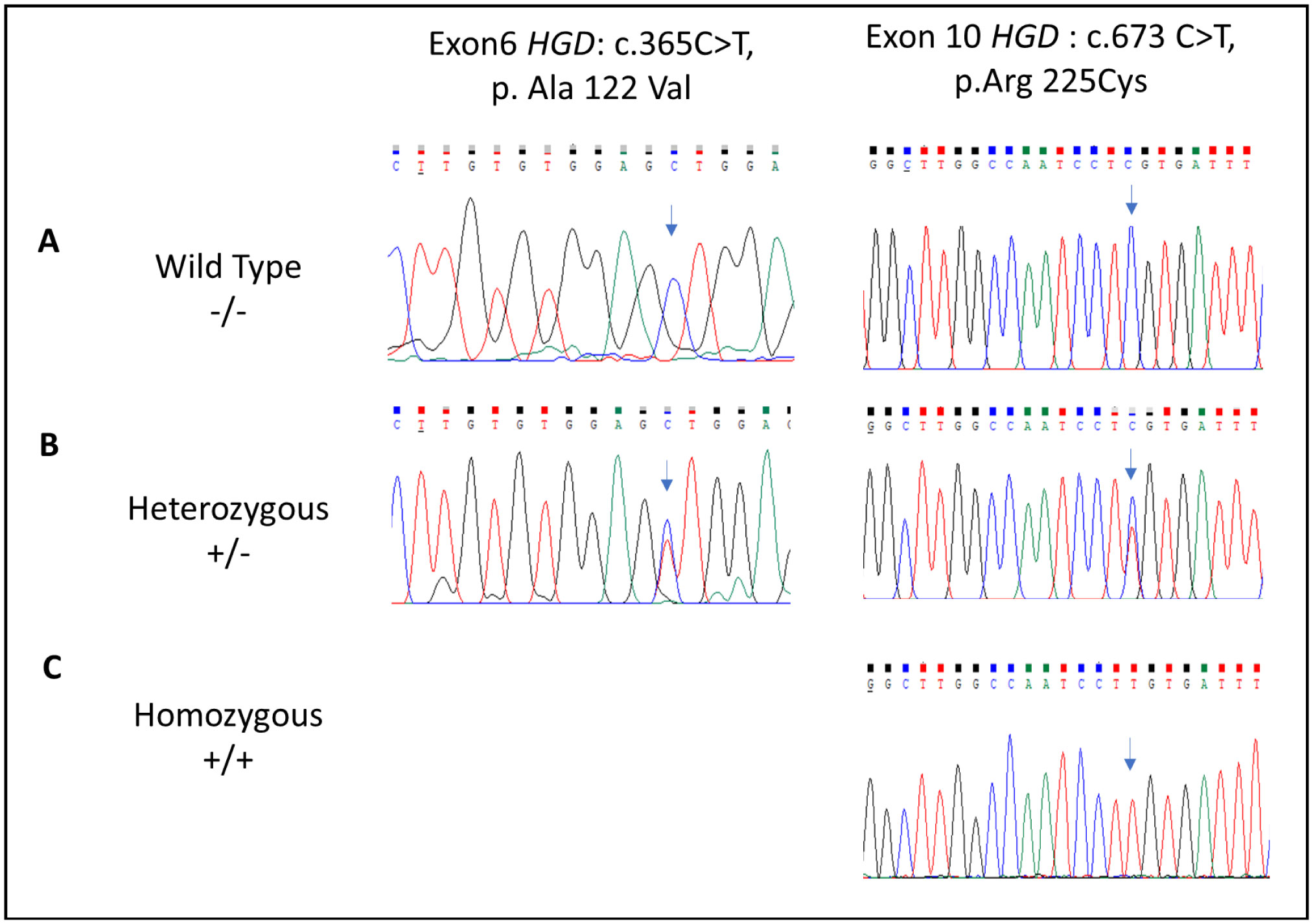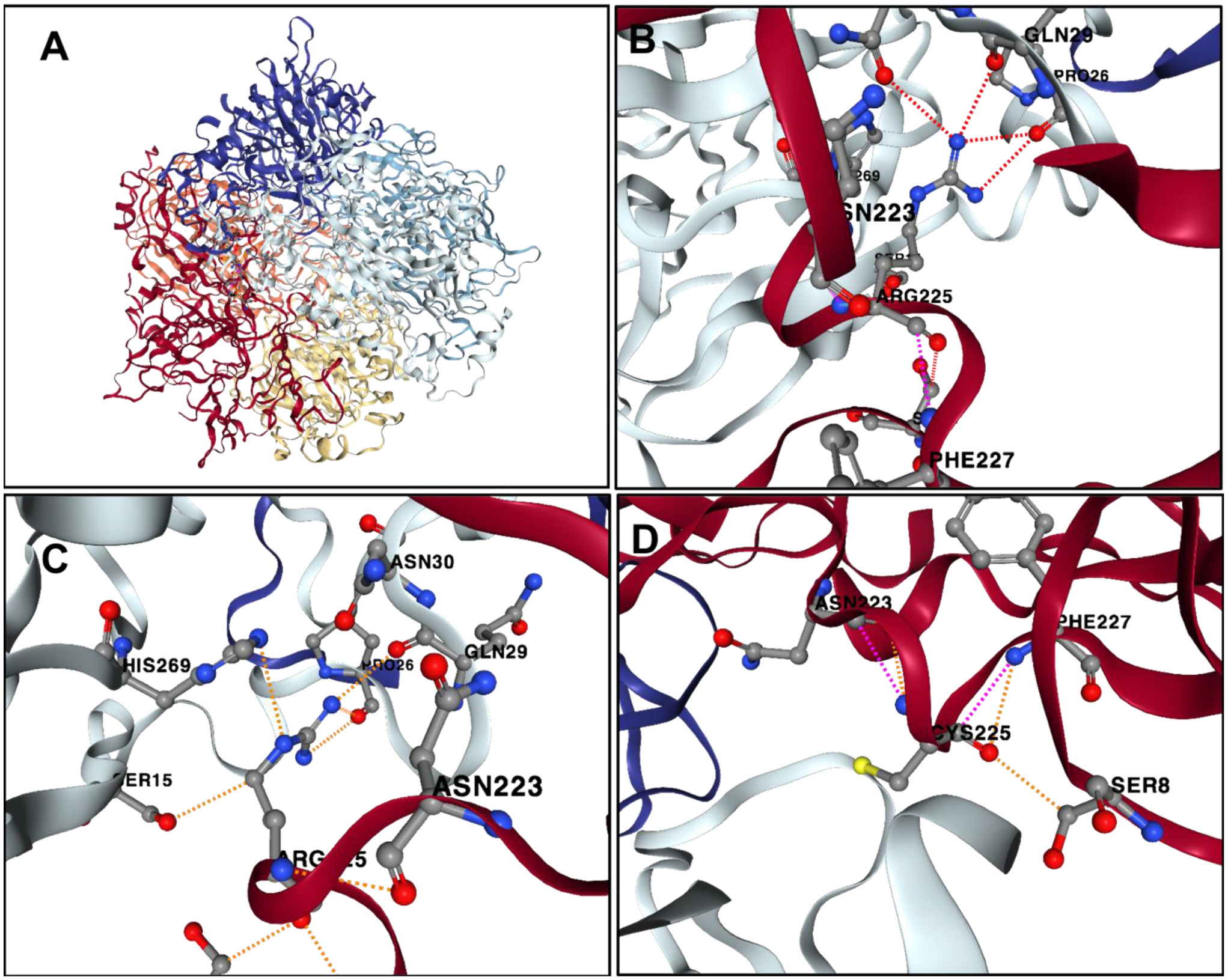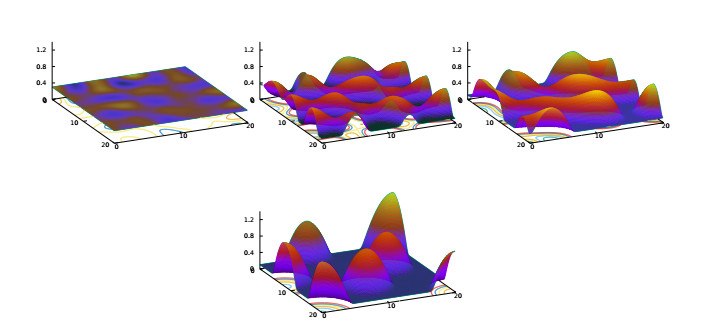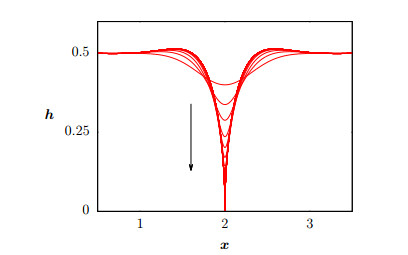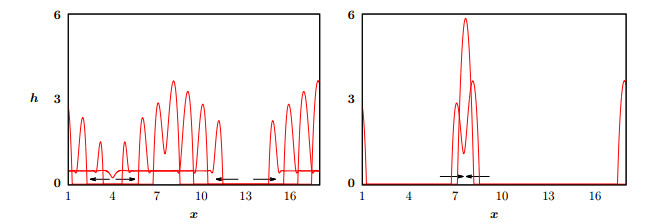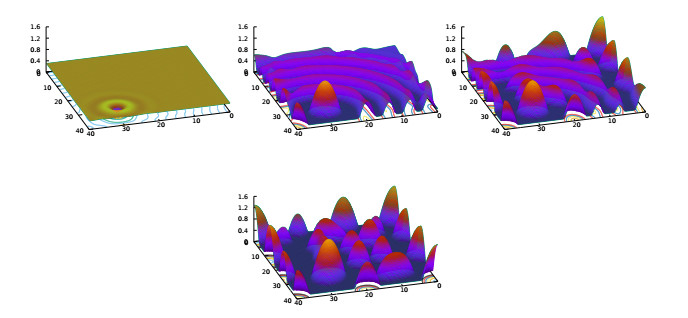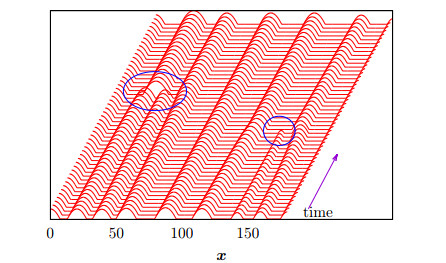|
[1]
|
D. J. Acheson, Elementary Fluid Dynamics, The Clarendon Press Oxford University Press, New York, 1990.
|
|
[2]
|
V. S. Ajaev, Evolution of dry patches in evaporating liquid films, Phys. Rev. E, 72 (2005), 031605.
|
|
[3]
|
V. S. Ajaev, Spreading of thin volatile liquid droplets on uniformly heated surfaces, J. Fluid Mech., 528 (2005), 279-296. doi: 10.1017/S0022112005003320

|
|
[4]
|
V. S. Ajaev, Interfacial Fluid Mechanics, Springer, New York, 2012.
|
|
[5]
|
V. S. Ajaev, E. Y. Gatapova, O. A. Kabov, Stability and break-up of thin liquid films on patterned and structured surfaces, Adv. Colloid Interface Sci., 228 (2016), 92-104. doi: 10.1016/j.cis.2015.11.011

|
|
[6]
|
V. S. Ajaev and G. M. Homsy, Steady vapor bubbles in rectangular microchannels, J. Colloid Interface Sci., 240 (2001), 259-271. doi: 10.1006/jcis.2001.7562

|
|
[7]
|
V. S. Ajaev, J. Klentzman, T. Gambaryan-Roisman, et al. Fingering instability of partially wetting evaporating liquids, J. Eng. Math., 73 (2012), 31-38. doi: 10.1007/s10665-010-9448-y

|
|
[8]
|
D. M. Anderson, M. K. Gupta, A. A. Voevodin, et al. Using amphiphilic nanostructures to enable long-range ensemble coalescence and surface rejuvenation in dropwise condensation, ACS Nano, 6 (2012), 3262-3268. doi: 10.1021/nn300183d

|
|
[9]
|
D. G. Aronson, The porous medium equation. In Nonlinear diffusion problems (Montecatini Terme, 1985), volume 1224 of Lecture Notes in Math., pages 1-46. Springer, Berlin, 1986.
|
|
[10]
|
M. Asgari and A. Moosavi, Coarsening dynamics of dewetting nanodroplets on chemically patterned substrates, Phys. Rev. E, 86 (2012), 016303.
|
|
[11]
|
G. I. Barenblatt, Scaling, Self-similarity, and Intermediate Asymptotics, Cambridge University Press, New York, 1996.
|
|
[12]
|
G. I. Barenblatt, Scaling, Cambridge University Press, New York, 2003.
|
|
[13]
|
J. Becker, G. Grün, R. Seemann, et al. Complex dewetting scenarios captured by thin-film models, Nat. Mater., 2 (2003), 59-63. doi: 10.1038/nmat788

|
|
[14]
|
P. Beltrame and U. Thiele, Time integration and steady-state continuation for 2d lubrication equations, SIAM J. Appl. Dyn. Syst., 9 (2010), 484-518. doi: 10.1137/080718619

|
|
[15]
|
F. Bernis, Finite speed of propagation and continuity of the interface for thin viscous flows, Adv. Differential Equ., 1 (1996), 337-368.
|
|
[16]
|
F. Bernis and A. Friedman, Higher order nonlinear degenerate parabolic equations, J. Differ. Equations, 83 (1990), 179-206. doi: 10.1016/0022-0396(90)90074-Y

|
|
[17]
|
F. Bernis, J. Hulshof, J. R. King, Dipoles and similarity solutions of the thin film equation in the half-line, Nonlinearity, 13 (2000), 413-439. doi: 10.1088/0951-7715/13/2/305

|
|
[18]
|
A. L. Bertozzi, Symmetric singularity formation in lubrication-type equations for interface motion, SIAM J. Appl. Math., 56 (1996), 681-714. doi: 10.1137/S0036139994271972

|
|
[19]
|
A. L. Bertozzi, The mathematics of moving contact lines in thin liquid films, Notices of the American Mathematical Society, 45 (1998), 689-697.
|
|
[20]
|
A. L. Bertozzi, M. P. Brenner, T. F. Dupont, et al. Singularities and similarities in interface flows. In Trends and perspectives in applied mathematics, pages 155-208. Springer, New York, 1994.
|
|
[21]
|
A. L. Bertozzi, G. Grün, T. P. Witelski, Dewetting films: bifurcations and concentrations, Nonlinearity, 14 (2001), 1569-1592. doi: 10.1088/0951-7715/14/6/309

|
|
[22]
|
A. L. Bertozzi and M. C. Pugh, The lubrication approximation for thin viscous films: the moving contact line with a "porous media" cut-off of van der Waals interactions, Nonlinearity, 7 (1994), 1535-1564. doi: 10.1088/0951-7715/7/6/002

|
|
[23]
|
A. L. Bertozzi and M. C. Pugh, The lubrication approximation for thin viscous films: regularity and long-time behavior of weak solutions, Commun. Pure Appl. Math., 49 (1996), 85-123. doi: 10.1002/(SICI)1097-0312(199602)49:2<85::AID-CPA1>3.0.CO;2-2

|
|
[24]
|
A. L. Bertozzi and M. C. Pugh, Long-wave instabilities and saturation in thin film equations, Commun. Pure Appl. Math., 51 (1998), 625-661. doi: 10.1002/(SICI)1097-0312(199806)51:6<625::AID-CPA3>3.0.CO;2-9

|
|
[25]
|
A. L. Bertozzi and M. C. Pugh, Finite-time blow-up of solutions of some long-wave unstable thin film equations, Indiana Univ. Math. J., 49 (2000), 1323-1366.
|
|
[26]
|
M. Bertsch, R. Dal Passo, H. Garcke, et al. The thin viscous flow equation in higher space dimensions, Adv. Differ. Equations, 3 (1998), 417-440.
|
|
[27]
|
J. Bischof, D. Scherer, S. Herminghaus, et al. Dewetting modes of thin metallic films: Nucleation of holes and spinodal dewetting, Phys. Rev. Lett., 77 (1996), 1536-1539. doi: 10.1103/PhysRevLett.77.1536

|
|
[28]
|
S. Boatto, L. P. Kadanoff, P. Olla, Traveling-wave solutions to thin-film equations, Phys. Rev. E, 48 (1993), 4423-4431.
|
|
[29]
|
D. Bonn, J. Eggers, J. Indekeu, et al. Wetting and spreading, Rev. Mod. Phys., 81 (2009), 739-805. doi: 10.1103/RevModPhys.81.739

|
|
[30]
|
M. Bowen, J. Hulshof, J. R. King, Anomalous exponents and dipole solutions for the thin film equation, SIAM J. Appl. Math., 62 (2001), 149-179. doi: 10.1137/S0036139900366936

|
|
[31]
|
R. J. Braun, Dynamics of the tear film, Annu. Rev. Fluid Mech., 44 (2012), 267-297. doi: 10.1146/annurev-fluid-120710-101042

|
|
[32]
|
L. Brusch, H. Kühne, U. Thiele, et al. Dewetting of thin films on heterogeneous substrates: Pinning versus coarsening, Phys. Rev. E, 66 (2002), 011602.
|
|
[33]
|
L. N. Brush and S. H. Davis, A new law of thinning in foam dynamics, J. Fluid Mech., 534 (2005), 227-236. doi: 10.1017/S0022112005004763

|
|
[34]
|
J. P. Burelbach, S. G. Bankoff, S. H. Davis, Nonlinear stability of evaporating/condensing liquid films, J. Fluid Mech., 195 (1988), 463-494. doi: 10.1017/S0022112088002484

|
|
[35]
|
J. A. Carrillo and G. Toscani, Long-time asymptotics for strong solutions of the thin film equation, Commun. Math. Phys., 225 (2002), 551-571. doi: 10.1007/s002200100591

|
|
[36]
|
A.-M. Cazabat and G. Guena, Evaporation of macroscopic sessile droplets, Soft Matter, 6 (2010), 2591-2612. doi: 10.1039/b924477h

|
|
[37]
|
S. J. Chapman, P. H. Trinh, T. P. Witelski, Exponential asymptotics for thin film rupture, SIAM J. Appl. Math., 73 (2013), 232-253. doi: 10.1137/120872012

|
|
[38]
|
K.-S. Chou and S.-Z. Du, Estimates on the Hausdorff dimension of the rupture set of a thin film, SIAM J. Math. Anal., 40 (2008), 790-823. doi: 10.1137/070685348

|
|
[39]
|
K.-S. Chou and Y.-C. Kwong, Finite time rupture for thin films under van der Waals forces, Nonlinearity, 20 (2007), 299-317. doi: 10.1088/0951-7715/20/2/004

|
|
[40]
|
P. Constantin, T. F. Dupont, R. E. Goldstein, et al. Droplet breakup in a model of the Hele-Shaw cell, Phys. Rev. E, 47 (1993), 4169-4181. doi: 10.1103/PhysRevE.47.4169

|
|
[41]
|
P. Constantin, T. Elgindi, H. Nguyen, et al. On singularity formation in a Hele-Shaw model, Commun. Math. Phys., 363 (2018), 139-171. doi: 10.1007/s00220-018-3241-6

|
|
[42]
|
R. V. Craster and O. K. Matar, Dynamics and stability of thin liquid films, Rev. Mod. Phys., 81(2009), 1131-1198. doi: 10.1103/RevModPhys.81.1131

|
|
[43]
|
M. C. Cross and P. C. Hohenberg, Pattern formation outside of equilibrium, Rev. Mod. Phys., 65 (1993), 851-1112. doi: 10.1103/RevModPhys.65.851

|
|
[44]
|
B. Dai, L. G. Leal, A. Redondo, Disjoining pressure for nonuniform thin films, Phys. Rev. E, 78 (2008), 061602.
|
|
[45]
|
S. B. Dai, On a mean field model for 1D thin film droplet coarsening, Nonlinearity, 23 (2010), 325-340. doi: 10.1088/0951-7715/23/2/006

|
|
[46]
|
S. B. Dai, On the Ostwald ripening of thin liquid films, Commun. Math. Sci., 9 (2011), 143-160. doi: 10.4310/CMS.2011.v9.n1.a7

|
|
[47]
|
S. B. Dai and R. L. Pego, Universal bounds on coarsening rates for mean-field models of phase transitions, SIAM J. Math. Anal., 37 (2005), 347-371. doi: 10.1137/040618047

|
|
[48]
|
R. Dal Passo, H. Garcke, G. Grün, On a fourth-order degenerate parabolic equation: global entropy estimates, existence, and qualitative behavior of solutions, SIAM J. Math. Anal., 29 (1998), 321-342. doi: 10.1137/S0036141096306170

|
|
[49]
|
R. Dal Passo, L. Giacomelli, A. Shishkov, The thin film equation with nonlinear diffusion, Commun. Part. Diff. Eq., 26 (2001), 1509-1557. doi: 10.1081/PDE-100107451

|
|
[50]
|
M. C. Dallaston, M. A. Fontelos, D. Tseluiko, et al. Discrete self-similarity in interfacial hydrodynamics and the formation of iterated structures, Phys. Rev. Lett., 120 (2018), 34505.
|
|
[51]
|
M. C. Dallaston, D. Tseluiko, Z. Zheng, et al. Self-similar finite-time singularity formation in degenerate parabolic equations arising in thin-film flows, Nonlinearity, 30 (2017), 2647-2666. doi: 10.1088/1361-6544/aa6eb3

|
|
[52]
|
A. A. Darhuber and S. M. Troian, Principles of microfluidic actuation by modulation of surface stresses, Annu. Rev. Fluid Mech., 37 (2005), 425-455. doi: 10.1146/annurev.fluid.36.050802.122052

|
|
[53]
|
A. A. Darhuber, S. M. Troian, S. M. Miller, et al. Morphology of liquid microstructures on chemically patterned surfaces, J. Appl. Phys., 87 (2000), 7768-7775. doi: 10.1063/1.373452

|
|
[54]
|
A. A. Darhuber, S. M. Troian, W. W. Reisner, Dynamics of capillary spreading along hydrophilic microstripes, Phys. Rev. E, 64 (2001), 031603.
|
|
[55]
|
B. Davidovitch, E. Moro, H. A. Stone, Spreading of viscous fluid drops on a solid substrate assisted by thermal fluctuations, Phys. Rev. Lett., 95 (2005), 244505.
|
|
[56]
|
P. G. de Gennes, Wetting - statics and dynamics, Rev. Mod. Phys., 57 (1985), 827-863. doi: 10.1103/RevModPhys.57.827

|
|
[57]
|
P. G. de Gennes, F. Brochard-Wyart, D. Quere, Capillarity and Wetting Phenomena: Drops, Bubbles, Pearls, Waves, Springer Verlag, New York, 2003.
|
|
[58]
|
M. di Bernardo, C. J. Budd, A. R. Champneys, et al. Piecewise-smooth Dynamical Systems, volume 163 of Applied Mathematical Sciences, Springer-Verlag London, Ltd., London, 2008.
|
|
[59]
|
J. A. Diez, A. G. Gonzalez, L. Kondic, On the breakup of fluid rivulets, Phys. Fluids, 21 (2009), 082105.
|
|
[60]
|
J. A. Diez and L. Kondic, On the breakup of fluid films of finite and infinite extent, Phys. Fluids, 19 (2007), 072107.
|
|
[61]
|
M. A. Durán-Olivencia, R. S. Gvalani, S. Kalliadasis, et al. Instability, rupture and fluctuations in thin liquid films: Theory and computations, J. Stat. Phys., 174 (2019), 579-604. doi: 10.1007/s10955-018-2200-0

|
|
[62]
|
M. Dziwnik, M. Korzec, A. Münch, et al. Stability analysis of unsteady, nonuniform base states in thin film equations, Multiscale Model. Sim., 12 (2014), 755-780. doi: 10.1137/130943352

|
|
[63]
|
E. Weinan, Principles of Multiscale Modeling, Cambridge University Press, Cambridge, 2011.
|
|
[64]
|
J. Eggers, Nonlinear dynamics and breakup of free-surface flows, Rev. Mod. Phys., 69 (1997), 865-929. doi: 10.1103/RevModPhys.69.865

|
|
[65]
|
J. Eggers and M. A. Fontelos, The role of self-similarity in singularities of partial differential equations, Nonlinearity, 22 (2009), R1-R44.
|
|
[66]
|
J. Eggers and M. A. Fontelos, Singularities: Formation, Structure, and Propagation, Cambridge University Press, 2015.
|
|
[67]
|
J. Eggers and L. Pismen, Nonlocal description of evaporating drops, Phys. Fluids, 22 (2010), 112101.
|
|
[68]
|
C. M. Elliott and H. Garcke, On the Cahn-Hilliard equation with degenerate mobility, SIAM J. Math. Anal., 27 (1996), 404-423. doi: 10.1137/S0036141094267662

|
|
[69]
|
S. Engelnkemper, S. V. Gurevich, H. Uecker, et al. Continuation for thin film hydrodynamics and related scalar problems. In Computational Modelling of Bifurcations and Instabilities in Fluid Dynamics, pages 459-501. Springer, 2019.
|
|
[70]
|
R. Enright, N. Miljkovic, J. L. Alvarado, et al. Dropwise condensation on micro-and nanostructured surfaces, Nanosc. Microsc. Therm., 18 (2014), 223-250. doi: 10.1080/15567265.2013.862889

|
|
[71]
|
P. L. Evans, J. R. King, A. Münch, Intermediate-asymptotic structure of a dewetting rim with strong slip, Applied Mathematics Research Express, 2006 (2006), 25262.
|
|
[72]
|
P. L. Evans, J. R. King, A. Münch, The structure of a dewetting rim with strong slip: the long-time evolution, Multiscale Model. Sim., 16 (2018), 1365-1391. doi: 10.1137/15M1051221

|
|
[73]
|
R. Fetzer, K. Jacobs, A. Munch, et al. New slip regimes and the shape of dewetting thin liquid films, Phys. Rev. Lett., 95 (2005), 127801.
|
|
[74]
|
J. Fischer and G. Grün, Existence of positive solutions to stochastic thin-film equations, SIAM J. Math. Anal., 50 (2018), 411-455. doi: 10.1137/16M1098796

|
|
[75]
|
L. S. Fisher and A. A. Golovin, Nonlinear stability analysis of a two-layer thin liquid film: Dewetting and autophobic behavior, J. Colloid Interf. Sci., 291 (2005), 515-528. doi: 10.1016/j.jcis.2005.05.024

|
|
[76]
|
Y. Gao, H. Ji, J.-G. Liu, et al. A vicinal surface model for epitaxial growth with logarithmic free energy, Discrete & Continuous Dynamical Systems-B, 23 (2018), 4433-4453.
|
|
[77]
|
Y. Gao, J.-G. Liu, X. Y. Lu, Gradient flow approach to an exponential thin film equation: global existence and latent singularity, ESAIM: Control, Optimisation and Calculus of Variations, 25 (2019), 49.
|
|
[78]
|
A. Ghatak, R. Khanna, A. Sharma, Dynamics and morphology of holes in dewetting thin films, J. Colloid Interf. Sci., 212 (1999), 483-494. doi: 10.1006/jcis.1998.6052

|
|
[79]
|
L. Giacomelli, A fourth-order degenerate parabolic equation describing thin viscous flows over an inclined plane, Appl. Math. Lett., 12 (1999), 107-111.
|
|
[80]
|
L. Giacomelli, M. V. Gnann, F. Otto, Regularity of source-type solutions to the thin-film equation with zero contact angle and mobility exponent between 3/2 and 3, Eur. J. Appl. Math., 24 (2013), 735-760. doi: 10.1017/S0956792513000156

|
|
[81]
|
L. Giacomelli and F. Otto, Rigorous lubrication approximation, Interfaces Free Bound., 5 (2003), 483-529.
|
|
[82]
|
M.-H. Giga, Y. Giga, J. Saal, Nonlinear Partial Differential Equations: Asymptotic Behavior of Solutions and Self-Similar Solutions, Birkhäuser Boston, Ltd., Boston, MA, 2010.
|
|
[83]
|
K. Glasner and S. Orizaga, Improving the accuracy of convexity splitting methods for gradient flow equations, J. Comput. Phys., 315 (2016), 52-64. doi: 10.1016/j.jcp.2016.03.042

|
|
[84]
|
K. Glasner, F. Otto, T. Rump, et al. Ostwald ripening of droplets: The role of migration, Eur. J. Appl. Math., 20 (2009), 1-67. doi: 10.1017/S0956792508007559

|
|
[85]
|
K. B. Glasner, Spreading of droplets under the influence of intermolecular forces, Phys. Fluids, 15 (2003), 1837-1842. doi: 10.1063/1.1578076

|
|
[86]
|
K. B. Glasner, Ostwald ripening in thin film equations, SIAM J. Appl. Math., 6 (2008), 473-493.
|
|
[87]
|
K. B. Glasner and T. P. Witelski, Coarsening dynamics of dewetting films, Phys. Rev. E, 67 (2003), 016302.
|
|
[88]
|
K. B. Glasner and T. P. Witelski, Collision versus collapse of droplets in coarsening of dewetting thin films, Physica D, 209 (2005), 80-104. doi: 10.1016/j.physd.2005.06.010

|
|
[89]
|
M. V. Gnann and M. Petrache, The Navier-slip thin-film equation for 3D fluid films: existence and uniqueness, J. Differ. Equations, 265 (2018), 5832-5958. doi: 10.1016/j.jde.2018.07.015

|
|
[90]
|
R. E. Goldstein, A. I. Pesci, M. J. Shelley, Attracting manifold for a viscous topology transition, Phys. Rev. Lett., 75 (1995), 3665-3668. doi: 10.1103/PhysRevLett.75.3665

|
|
[91]
|
C. P. Grant, Spinodal decomposition for the Cahn-Hilliard equation, Commun. Part. Diff. Eq., 18 (1993), 453-490. doi: 10.1080/03605309308820937

|
|
[92]
|
M. B. Gratton and T. P. Witelski, Transient and self-similar dynamics in thin film coarsening, Physica D, 238 (2009), 2380-2394. doi: 10.1016/j.physd.2009.09.015

|
|
[93]
|
H. P. Greenspan, On the motion of a small viscous droplet that wets a surface, J. Fluid Mech., 84 (1978), 125-143. doi: 10.1017/S0022112078000075

|
|
[94]
|
G. Grün, K. Mecke, M. Rauscher, Thin-film flow influenced by thermal noise, J. Stat. Phys., 122 (2006), 1261-1291. doi: 10.1007/s10955-006-9028-8

|
|
[95]
|
G. Grün and M. Rumpf, Nonnegativity preserving convergent schemes for the thin film equation, Numer. Math., 87 (2000), 113-152. doi: 10.1007/s002110000197

|
|
[96]
|
G. Grün and M. Rumpf, Simulation of singularities and instabilities arising in thin film flow, Eur. J. Appl. Math., 12 (2001), 293-320. doi: 10.1017/S0956792501004429

|
|
[97]
|
E. K. O. Hellen and J. Krug, Coarsening of sand ripples in mass transfer models, Phys. Rev. E, 66 (2002), 011304.
|
|
[98]
|
D. Herde, U. Thiele, S. Herminghaus, et al. Driven large contact angle droplets on chemically heterogeneous substrates, EPL, 100 (2012), 16002.
|
|
[99]
|
S. Herminghaus, M. Brinkmann, R. Seemann, Wetting and dewetting of complex surface geometries, Annu. Rev. Mater. Res., 38 (2008), 101-121. doi: 10.1146/annurev.matsci.38.060407.130335

|
|
[100]
|
S. Herminghaus and F. Brochard, Dewetting though nucleation, C. R. Phys., 7 (2006), 1073-1081. doi: 10.1016/j.crhy.2006.10.021

|
|
[101]
|
S. Herminghaus, K. Jacobs, K. Mecke, et al. Spinodal dewetting in liquid crystal and liquid metal films, Science, 282 (1998), 916-919.
|
|
[102]
|
L. M. Hocking, The influence of intermolecular forces on thin fluid layers, Phys. Fluids, 5 (1993), 793-798. doi: 10.1063/1.858627

|
|
[103]
|
C. Huh and L. E. Scriven, Hydrodynamic model of steady movement of a solid/liquid/fluid contact line, J. Colloid Interf. Sci., 35 (1971), 85-101. doi: 10.1016/0021-9797(71)90188-3

|
|
[104]
|
H. J. Hwang and T. P. Witelski, Short-time pattern formation in thin film equations, Discrete and Continuous Dynamical Systems. Series A, 23 (2009), 867-885. doi: 10.3934/dcds.2009.23.867

|
|
[105]
|
J. N. Israelachvili, Intermolecular and Surface Forces, Academic Press, New York, 1992.
|
|
[106]
|
K. Jacobs, R. Seemann, S. Herminghaus, Stability and dewetting of thin liquid films. In Polymer thin films, pages 243-265. World Scientific, 2008.
|
|
[107]
|
H. Ji and T. P. Witelski, Finite-time thin film rupture driven by modified evaporative loss, Physica D, 342 (2017), 1-15. doi: 10.1016/j.physd.2016.10.002

|
|
[108]
|
H. Ji and T. P. Witelski, Instability and dynamics of volatile thin films, Phys. Rev. Fluids, 3 (2018), 024001.
|
|
[109]
|
H. Ji and T. P. Witelski, Steady states and dynamics of a thin-film-type equation with nonconserved mass, Eur. J. Appl. Math., (2019), 1-34.
|
|
[110]
|
H. Jiang and W.-M. Ni, On steady states of van der Waals force driven thin film equations, Eur. J. Appl. Math., 18 (2007), 153-180. doi: 10.1017/S0956792507006936

|
|
[111]
|
S. Kalliadasis, C. Ruyer-Quil, B. Scheid, et al. Falling Liquid Films, volume 176 of Applied Mathematical Sciences, Springer, London, 2012.
|
|
[112]
|
H. S. Kheshgi and L. E. Scriven, Dewetting - nucleation and growth of dry regions, Chem. Eng. Sci., 46 (1991), 519-526. doi: 10.1016/0009-2509(91)80012-N

|
|
[113]
|
J. R. King, Two generalisations of the thin film equation, Math. Comput. Model., 34 (2001), 737-756. doi: 10.1016/S0895-7177(01)00095-4

|
|
[114]
|
J. R. King and M. Bowen, Moving boundary problems and non-uniqueness for the thin film equation, Eur. J. Appl. Math., 12 (2001), 321-356. doi: 10.1017/S0956792501004405

|
|
[115]
|
J. R. King, A. Münch, B. Wagner, Linear stability of a ridge, Nonlinearity, 19 (2006), 2813-2831. doi: 10.1088/0951-7715/19/12/005

|
|
[116]
|
J. R. King, A. Münch, B. A. Wagner, Linear stability analysis of a sharp-interface model for dewetting thin films, J. Eng. Math., 63 (2009), 177-195. doi: 10.1007/s10665-008-9242-2

|
|
[117]
|
G. Kitavtsev, L. Recke, B. Wagner, Centre manifold reduction approach for the lubrication equation, Nonlinearity, 24 (2011), 2347-2369. doi: 10.1088/0951-7715/24/8/010

|
|
[118]
|
G. Kitavtsev, L. Recke, B. Wagner, Asymptotics for the spectrum of a thin film equation in a singular limit, SIAM J. Appl. Dyn. Syst., 11 (2012), 1425-1457. doi: 10.1137/100813488

|
|
[119]
|
R. V. Kohn and F. Otto, Upper bounds on coarsening rates, Commun. Math. Phys., 229 (2002), 275-295.
|
|
[120]
|
R. Konnur, K. Kargupta, A. Sharma, Instability and morphology of thin liquid films on chemically heterogeneous substrates, Phys. Rev. Lett., 84 (2000), 931-934. doi: 10.1103/PhysRevLett.84.931

|
|
[121]
|
M.-A. Y.-H. Lam, L. J. Cummings, L. Kondic, Computing dynamics of thin films via large scale GPU-based simulations, Journal of Computational Physics: X, 2 (2019), 100001.
|
|
[122]
|
E. Lauga, M. P. Brenner, H. A. Stone, Microfluidics: The no-slip boundary condition. In J. Foss, C. Tropea, and A. Yarin, editors, Handbook of Experimental Fluid Dynamics, chapter 19, pages 1-27. Springer, 2007.
|
|
[123]
|
R. S. Laugesen and M. C. Pugh, Linear stability of steady states for thin film and Cahn-Hilliard type equations, Arch. Ration. Mech. An., 154 (2000), 3-51. doi: 10.1007/PL00004234

|
|
[124]
|
R. S. Laugesen and M. C. Pugh, Properties of steady states for thin film equations, Eur. J. Appl. Math., 11 (2000), 293-351. doi: 10.1017/S0956792599003794

|
|
[125]
|
R. S. Laugesen and M. C. Pugh, Energy levels of steady states for thin-film-type equations, J. Differ. Equations, 182 (2002), 377-415. doi: 10.1006/jdeq.2001.4108

|
|
[126]
|
R. S. Laugesen and M. C. Pugh, Heteroclinic orbits, mobility parameters and stability for thin film type equations, Electron. J. Differ. Eq., 2002 (2002), 1-29.
|
|
[127]
|
R. N. Leach, F. Stevens, S. C. Langford, et al. Dropwise condensation: Experiments and simulations of nucleation and growth of water drops in a cooling system, Langmuir, 22 (2006), 8864-8872. doi: 10.1021/la061901+

|
|
[128]
|
L. G. Leal, Advanced Transport Phenomena: Fluid Mechanics and Convective Transport Processes, Cambridge University Press, 2007.
|
|
[129]
|
I. M. Lifshitz and V. V. Slyozov, The kinetics of precipitation from supersaturated solid solutions, J. Phys. Chem. Solids, 19 (1961), 35-50. doi: 10.1016/0022-3697(61)90054-3

|
|
[130]
|
R. Limary and P. F. Green, Dewetting instabilities in thin block copolymer films: nucleation and growth, Langmuir, 15 (1999), 5617-5622. doi: 10.1021/la981693o

|
|
[131]
|
R. Limary and P. F. Green, Dynamics of droplets on the surface of a structured fluid film: latestage coarsening, Langmuir, 19 (2003), 2419-2424. doi: 10.1021/la026560o

|
|
[132]
|
F. Liu, G. Ghigliotti, J. J. Feng, et al. Numerical simulations of self-propelled jumping upon drop coalescence on non-wetting surfaces, J. Fluid Mech., 752 (2014), 39-65. doi: 10.1017/jfm.2014.320

|
|
[133]
|
W. Liu and T. P. Witelski, Steady-states of thin film droplets on chemically heterogeneous substrates, preprint, 2020.
|
|
[134]
|
A. M. Macner, S. Daniel, P. H. Steen, Condensation on surface energy gradient shifts drop size distribution toward small drops, Langmuir, 30 (2014), 1788-1798. doi: 10.1021/la404057g

|
|
[135]
|
J. A. Marqusee and J. Ross, Kinetics of phase transitions: Theory of Ostwald ripening, J. Chem. Phys., 79 (1983), 373-378. doi: 10.1063/1.445532

|
|
[136]
|
L. C. Mayo, S. W. McCue, T. J. Moroney, et al. Simulating droplet motion on virtual leaf surfaces, Roy. Soc. Open Sci., 2 (2015), 140528.
|
|
[137]
|
K. Mecke and M. Rauscher, On thermal fluctuations in thin film flow, Journal of Physics: Condensed Matter, 17 (2005), S3515.
|
|
[138]
|
N. Miljkovic, R. Enright, E. N. Wang, Effect of droplet morphology on growth dynamics and heat transfer during condensation on superhydrophobic nanostructured surfaces, ACS Nano, 6 (2012), 1776-1785. doi: 10.1021/nn205052a

|
|
[139]
|
A. Miranville, The Cahn-Hilliard equation and some of its variants, AIMS Mathematics, 2 (2017), 479-544. doi: 10.3934/Math.2017.2.479

|
|
[140]
|
V. Mitlin, Dewetting revisited: New asymptotics of the film stability diagram and the metastable regime of nucleation and growth of dry zones, J. Colloid Interf. Sci., 227 (2000), 371-379. doi: 10.1006/jcis.2000.6792

|
|
[141]
|
V. S. Mitlin, Dewetting of a solid surface: analogy with spinodal decomposition, J. Colloid Interf. Sci., 156 (1993), 491-497. doi: 10.1006/jcis.1993.1142

|
|
[142]
|
V. S. Mitlin and N. V. Petviashvili, Nonlinear dynamics of dewetting: kinetically stable structures, Phys. Lett. A, 192 (1994), 323-326. doi: 10.1016/0375-9601(94)90213-5

|
|
[143]
|
R. Mukherjee and A. Sharma, Instability, self-organization and pattern formation in thin soft films, Soft matter, 11 (2015), 8717-8740. doi: 10.1039/C5SM01724F

|
|
[144]
|
A. Münch and B. Wagner, Contact-line instability of dewetting thin films, Physica D, 209 (2005), 178-190. doi: 10.1016/j.physd.2005.06.027

|
|
[145]
|
A. Münch, B. Wagner, T. P. Witelski, Lubrication models with small to large slip lengths, J. Eng. Math., 53 (2005), 359-383. doi: 10.1007/s10665-005-9020-3

|
|
[146]
|
N. Murisic and L. Kondic, On evaporation of sessile drops with moving contact lines, J. Fluid Mech., 679 (2011), 219-246. doi: 10.1017/jfm.2011.133

|
|
[147]
|
T. G. Myers, Thin films with high surface tension, SIAM Review, 40 (1998), 441-462. doi: 10.1137/S003614459529284X

|
|
[148]
|
C. Neto, K. Jacobs, R. Seemann, et al. Correlated dewetting patterns in thin polystyrene films, Journal of Physics: Condensed Matter, 15 (2003), S421-S426.
|
|
[149]
|
C. Neto, K. Jacobs, R. Seemann, et al. Satellite hole formation during dewetting: experiment and simulation, Journal of Physics: Condensed Matter, 15 (2003), 3355-3366. doi: 10.1088/0953-8984/15/19/334

|
|
[150]
|
B. Niethammer, Derivation of the LSW-theory for Ostwald ripening by homogenization methods, Arch. Ration. Mech. An., 147 (1999), 119-178. doi: 10.1007/s002050050147

|
|
[151]
|
B. Niethammer, The mathematics of Ostwald ripening. In Geometric analysis and nonlinear partial differential equations, pages 649-663. Springer, Berlin, 2003.
|
|
[152]
|
B. Niethammer and R. L. Pego, Non-self-similar behavior in the LSW theory of Ostwald ripening, J. Stat. Phys., 95 (1999), 867-902. doi: 10.1023/A:1004546215920

|
|
[153]
|
B. Niethammer and R. L. Pego, On the initial-value problem in the Lifshitz-Slyozov-Wagner theory of Ostwald ripening, SIAM J. Math. Anal., 31 (2000), 467-485. doi: 10.1137/S0036141098338211

|
|
[154]
|
B. Niethammer and R. L. Pego, Well-posedness for measure transport in a family of nonlocal domain coarsening models, Indiana U. Math. J., 54 (2005), 499-530. doi: 10.1512/iumj.2005.54.2598

|
|
[155]
|
B. Niethammer and J. J. L. Velázquez, On the convergence to the smooth self-similar solution in the LSW model, Indiana U. Math. J., 55 (2006), 761-794. doi: 10.1512/iumj.2006.55.2854

|
|
[156]
|
A. Novick-Cohen, The Cahn-Hilliard equation. In Handbook of differential equations: evolutionary equations. Vol. IV, Handb. Differ. Equ., pages 201-228. Elsevier/North-Holland, Amsterdam, 2008.
|
|
[157]
|
A. Novick-Cohen and L. A. Segel, Nonlinear aspects of the Cahn-Hilliard equation, Physica D, 10 (1984), 277-298. doi: 10.1016/0167-2789(84)90180-5

|
|
[158]
|
J. R. Ockendon and H. Ockendon, Viscous Flow, Cambridge University, Cambridge, 1995.
|
|
[159]
|
A. Oron and S. G. Bankoff, Dewetting of a heated surface by an evaporating liquid film under conjoining/disjoining pressures, J. Colloid Interf. Sci., 218 (1999), 152-166. doi: 10.1006/jcis.1999.6390

|
|
[160]
|
A. Oron and S. G. Bankoff, Dynamics of a condensing liquid film under conjoining/disjoining pressures, Phys. Fluids, 13 (2001), 1107-1117. doi: 10.1063/1.1355022

|
|
[161]
|
A. Oron, S. H. Davis, S. G. Bankoff, Long-scale evolution of thin liquid films, Rev. Mod. Phys., 69 (1997), 931-980. doi: 10.1103/RevModPhys.69.931

|
|
[162]
|
F. Otto, T. Rump, D. Slepcev, Coarsening rates for a droplet model: rigorous upper bounds, SIAM J. Math. Anal., 38 (2006), 503-529. doi: 10.1137/050630192

|
|
[163]
|
S. B. G. O'Brien and L. W. Schwartz, Theory and Modeling of Thin Film Flows, In Encyclopedia of Surface and Colloid Science, pages 5283-5297. Marcel Dekker, 2002.
|
|
[164]
|
A. A. Pahlavan, L. Cueto-Felgueroso, A. E. Hosoi, et al. Thin films in partial wetting: Stability, dewetting and coarsening, J. Fluid Mech., 845 (2018), 642-681. doi: 10.1017/jfm.2018.255

|
|
[165]
|
A. A. Pahlavan, L. Cueto-Felgueroso, G. H. McKinley, et al. Thin films in partial wetting: internal selection of contact-line dynamics, Phys. Rev. Lett., 115 (2015), 034502.
|
|
[166]
|
D. Peschka, S. Haefner, L. Marquant, et al. Signatures of slip in dewetting polymer films, P. Natl. Acad. Sci. USA, 116 (2019), 9275-9284. doi: 10.1073/pnas.1820487116

|
|
[167]
|
L. M. Pismen, Spinodal dewetting in a volatile liquid film, Phys. Rev. E, 70 (2004), 021601.
|
|
[168]
|
L. M. Pismen and Y. Pomeau, Mobility and interactions of weakly nonwetting droplets, Phys. Fluids, 16 (2004), 2604-2612. doi: 10.1063/1.1758911

|
|
[169]
|
A. Pototsky, M. Bestehorn, D. Merkt, et al. Alternative pathways of dewetting for a thin liquid two-layer film, Phys. Rev. E, 70 (2004), 025201.
|
|
[170]
|
C. Pozrikidis, Boundary Integral and Singularity Methods for Linearized Viscous Flow, Cambridge Texts in Applied Mathematics. Cambridge University Press, Cambridge, 1992.
|
|
[171]
|
M. Rauscher and S. Dietrich, Wetting phenomena in nanofluidics, Annu. Rev. Mater. Res., 38 (2008), 143-172. doi: 10.1146/annurev.matsci.38.060407.132451

|
|
[172]
|
G. Reiter, Dewetting of thin polymer films, Phys. Rev. Lett., 68 (1992), 75-78. doi: 10.1103/PhysRevLett.68.75

|
|
[173]
|
S. N. Reznik and A. L. Yarin, Spreading of a viscous drop due to gravity and capillarity on a horizontal or an inclined dry wall, Phys. Fluids, 14 (2002), 118-132. doi: 10.1063/1.1426388

|
|
[174]
|
A. J. Roberts and Z. Li, An accurate and comprehensive model of thin fluid flows with inertia on curved substrates, J. Fluid Mech., 553 (2006), 33-73. doi: 10.1017/S0022112006008640

|
|
[175]
|
N. O. Rojas, M. Argentina, E. Cerda, et al. Inertial lubrication theory, Phys. Rev. Lett., 104 (2010), 187801.
|
|
[176]
|
J. W. Rose, On the mechanism of dropwise condensation, Int. J. Heat Mass Tran., 10 (1967), 755-762. doi: 10.1016/0017-9310(67)90135-4

|
|
[177]
|
J. W. Rose, Dropwise condensation theory and experiment: A review, Journal of Power Energy, 216 (2012), 115-128.
|
|
[178]
|
R. V. Roy, A. J. Roberts, M. E. Simpson, A lubrication model of coating flows over a curved substrate in space, J. Fluid Mech., 454 (2002), 235-261. doi: 10.1017/S0022112001007133

|
|
[179]
|
E. Ruckenstein and R. K. Jain, Spontaneous rupture of thin liquid films, Journal of the Chemical Society-Faraday Transactions II, 70 (1974), 132-147. doi: 10.1039/f29747000132

|
|
[180]
|
K. Rykaczewski, A. T. Paxson, M. Staymates, et al. Dropwise condensation of low surface tension fluids on omniphobic surfaces, Scientific reports, 4 (2015), 4158.
|
|
[181]
|
E. Sander and T. Wanner, Monte Carlo simulations for spinodal decomposition, J. Stat. Phys., 95 (1999), 925-948. doi: 10.1023/A:1004550416829

|
|
[182]
|
E. Sander and T. Wanner, Unexpectedly linear behavior for the Cahn-Hilliard equation, SIAM J. Appl. Math., 60 (2000), 2182-2202. doi: 10.1137/S0036139999352225

|
|
[183]
|
L. W. Schwartz, Unsteady simulation of viscous thin-layer flows. In P. A. Tyvand, editor, Free surface flows with viscosity, pages 203-233. Computational Mechanics Publications, Boston, 1997.
|
|
[184]
|
L. W. Schwartz, R. V. Roy, R. R. Eley, et al. Dewetting patterns in a drying liquid film, J. Colloid Interf. Sci., 234 (2001), 363-374. doi: 10.1006/jcis.2000.7312

|
|
[185]
|
L. W. Schwartz and D. E. Weidner, Modeling of coating flows on curved surfaces, J. Eng. Math., 29 (1995), 91-103. doi: 10.1007/BF00046385

|
|
[186]
|
R. Seemann, S. Herminghaus, K. Jacobs, Dewetting patterns and molecular forces: a reconciliation, Phys. Rev. Lett., 86 (2001), 5534-5537. doi: 10.1103/PhysRevLett.86.5534

|
|
[187]
|
A. Sharma, Many paths to dewetting of thin films, Eur. Phys. J. E, 12 (2003), 397-407. doi: 10.1140/epje/e2004-00008-5

|
|
[188]
|
A. Sharma and R. Khanna, Pattern formation in unstable thin liquid films, Phys. Rev. Lett., 81 (1998), 3463-3466. doi: 10.1103/PhysRevLett.81.3463

|
|
[189]
|
A. Sharma and G. Reiter, Instability of thin polymer films on coated substrates: rupture, dewetting, and drop formation, J. Colloid Interf. Sci., 178 (1996), 383-399. doi: 10.1006/jcis.1996.0133

|
|
[190]
|
A. Sharma and R. Verma, Pattern formation and dewetting in thin films of liquids showing complete macroscale wetting: From "pancakes" to "swiss cheese", Langmuir, 20 (2004), 10337-10345. doi: 10.1021/la048669x

|
|
[191]
|
D. N. Sibley, A. Nold, N. Savva, et al. A comparison of slip, disjoining pressure, and interface formation models for contact line motion through asymptotic analysis of thin two-dimensional droplet spreading, J. Eng. Math., 94 (2015), 19-41.
|
|
[192]
|
V. M. Starov, M. G. Velarde, C. J. Radke, Wetting and Spreading Dynamics, CRC Press, Boca Raton Florida, 2007.
|
|
[193]
|
P. S. Stewart and S. H. Davis, Dynamics and stability of metallic foams: Network modeling, J. Rheol., 56 (2012), 543-574. doi: 10.1122/1.3695029

|
|
[194]
|
P. S. Stewart and S. H. Davis, Self-similar coalescence of clean foams, J. Fluid Mech., 722 (2013), 645-664. doi: 10.1017/jfm.2013.145

|
|
[195]
|
H. A. Stone, A. D. Stroock, A. Ajdari, Engineering flows in small devices: microfluidics toward a lab-on-a-chip, Annu. Rev. Fluid Mech., 36 (2004), 381-411. doi: 10.1146/annurev.fluid.36.050802.122124

|
|
[196]
|
U. Thiele, Open questions and promising new fields in dewetting, Eur. Phys. J. E, 12 (2003), 409-414. doi: 10.1140/epje/e2004-00009-4

|
|
[197]
|
U. Thiele, Thin film evolution equations from (evaporating) dewetting liquid layers to epitaxial growth, Journal of Physics: Condensed Matter, 22 (2010), 084019.
|
|
[198]
|
U. Thiele, Patterned deposition at moving contact lines, Adv. Colloid Interfac., 206 (2014), 399-413. doi: 10.1016/j.cis.2013.11.002

|
|
[199]
|
U. Thiele, Recent advances in and future challenges for mesoscopic hydrodynamic modelling of complex wetting, Colloids and Surfaces A, 553 (2018), 487-495. doi: 10.1016/j.colsurfa.2018.05.049

|
|
[200]
|
U. Thiele, A. J. Archer, L. M. Pismen, Gradient dynamics models for liquid films with soluble surfactant, Phys. Rev. Fluids, 1 (2016), 083903.
|
|
[201]
|
U. Thiele, A. J. Archer, M. Plapp, Thermodynamically consistent description of the hydrodynamics of free surfaces covered by insoluble surfactants of high concentration, Phys. Fluids, 24 (2012), 102107.
|
|
[202]
|
U. Thiele and E. Knobloch, Driven drops on heterogeneous substrates: Onset of sliding motion, Phys. Rev. Lett., 97 (2006), 204501.
|
|
[203]
|
U. Thiele, M. Mertig, W. Pompe, Dewetting of an evaporating thin liquid film: Heterogeneous nucleation and surface instability, Phys. Rev. Lett., 80 (1998), 2869-2872. doi: 10.1103/PhysRevLett.80.2869

|
|
[204]
|
U. Thiele, M. G. Velarde, K. Neuffer, et al. Film rupture in the diffuse interface model coupled to hydrodynamics, Phys. Rev. E, 64 (2001), 031602.
|
|
[205]
|
D. Tseluiko and D. T. Papageorgiou, Nonlinear dynamics of electrified thin liquid films, SIAM J. Appl. Math., 67 (2007), 1310-1329. doi: 10.1137/060663532

|
|
[206]
|
D. Tseluiko, J. Baxter, U. Thiele, A homotopy continuation approach for analysing finite-time singularities in thin liquid films, IMA J. Appl. Math., 78 (2013), 762-776. doi: 10.1093/imamat/hxt021

|
|
[207]
|
H. B. van Lengerich, M. J. Vogel, P. H. Steen, Coarsening of capillary drops coupled by conduit networks, Phys. Rev. E, 82 (2010), 66312.
|
|
[208]
|
F. Vandenbrouck, M. P. Valignat, A. M. Cazabat, Thin nematic films: metastability and spinodal dewetting, Phys. Rev. Lett., 82 (1999), 2693-2696. doi: 10.1103/PhysRevLett.82.2693

|
|
[209]
|
S. J. VanHook, M. F. Schatz, W. D. McCormick, et al. Long-wavelength surface-tension-driven Bénard convection: experiment and theory, J. Fluid Mech., 345 (1997), 45-78. doi: 10.1017/S0022112097006101

|
|
[210]
|
J. L. Vázquez, The Porous Medium Equation, Oxford Mathematical Monographs. The Clarendon Press, Oxford University Press, Oxford, 2007.
|
|
[211]
|
A. Vrij, Possible mechanism for spontaneous rupture of thin free liquid films, Discussions of the Faraday Society, 42 (1966), 23-33. doi: 10.1039/df9664200023

|
|
[212]
|
C. Wagner, Theorie der alterung von niedershlagen durch umlosen (Ostwald-Reifung), Z. Elektrochem, 65 (1961), 581-591.
|
|
[213]
|
M. H. Ward, Interfacial thin films rupture and self-similarity, Phys. Fluids, 23 (2011), 062105.
|
|
[214]
|
S. J. Watson, F. Otto, B. Y. Rubinstein, et al. Coarsening dynamics of the convective Cahn-Hilliard equation, Physica D, 178 (2003), 127-148. doi: 10.1016/S0167-2789(03)00048-4

|
|
[215]
|
T. Wei and F. Duan, Interfacial stability and self-similar rupture of evaporating liquid layers under vapor recoil, Phys. Fluids, 28 (2016), 124106.
|
|
[216]
|
G. M. Whitesides, The origins and the future of microfluidics, Nature, 442 (2006), 368-373. doi: 10.1038/nature05058

|
|
[217]
|
M. B. Williams and S. H. Davis, Nonlinear theory of film rupture, J. Colloid Interf. Sci., 90 (1982), 220-228. doi: 10.1016/0021-9797(82)90415-5

|
|
[218]
|
T. P. Witelski, Computing finite-time singularities in interfacial flows. In G. Sabidussi, editor, Modern Methods in Scientific Computing and Applications, NATO ASI series proceedings, pages 451-487. Kluwer, 2002.
|
|
[219]
|
T. P. Witelski and A. J. Bernoff, Stability of self-similar solutions for van der Waals driven thin film rupture, Phys. Fluids, 11 (1999), 2443-2445. doi: 10.1063/1.870138

|
|
[220]
|
T. P. Witelski and A. J. Bernoff, Dynamics of three-dimensional thin film rupture, Physica D, 147 (2000), 155-176. doi: 10.1016/S0167-2789(00)00165-2

|
|
[221]
|
T. P. Witelski, A. J. Bernoff, A. L. Bertozzi, Blowup and dissipation in a critical-case unstable thin film equation, Eur. J. Appl. Math., 15 (2004), 223-256. doi: 10.1017/S0956792504005418

|
|
[222]
|
T. P. Witelski and M. Bowen, ADI schemes for higher-order nonlinear diffusion equations, Appl. Numer. Math., 45 (2003), 331-351. doi: 10.1016/S0168-9274(02)00194-0

|
|
[223]
|
Q. Wu and H. Wong, A slope-dependent disjoining pressure for non-zero contact angles, J. Fluid Mech., 506 (2004), 157-185. doi: 10.1017/S0022112004008420

|
|
[224]
|
W. W. Zhang and J. R. Lister, Similarity solutions for van der Waals rupture of a thin film on a solid substrate, Phys. Fluids, 11 (1999), 2454-2462. doi: 10.1063/1.870110

|
|
[225]
|
L. Zhornitskaya and A. L. Bertozzi, Positivity-preserving numerical schemes for lubrication-type equations, SIAM J. Numer. Anal., 37 (2000), 523-555.
|
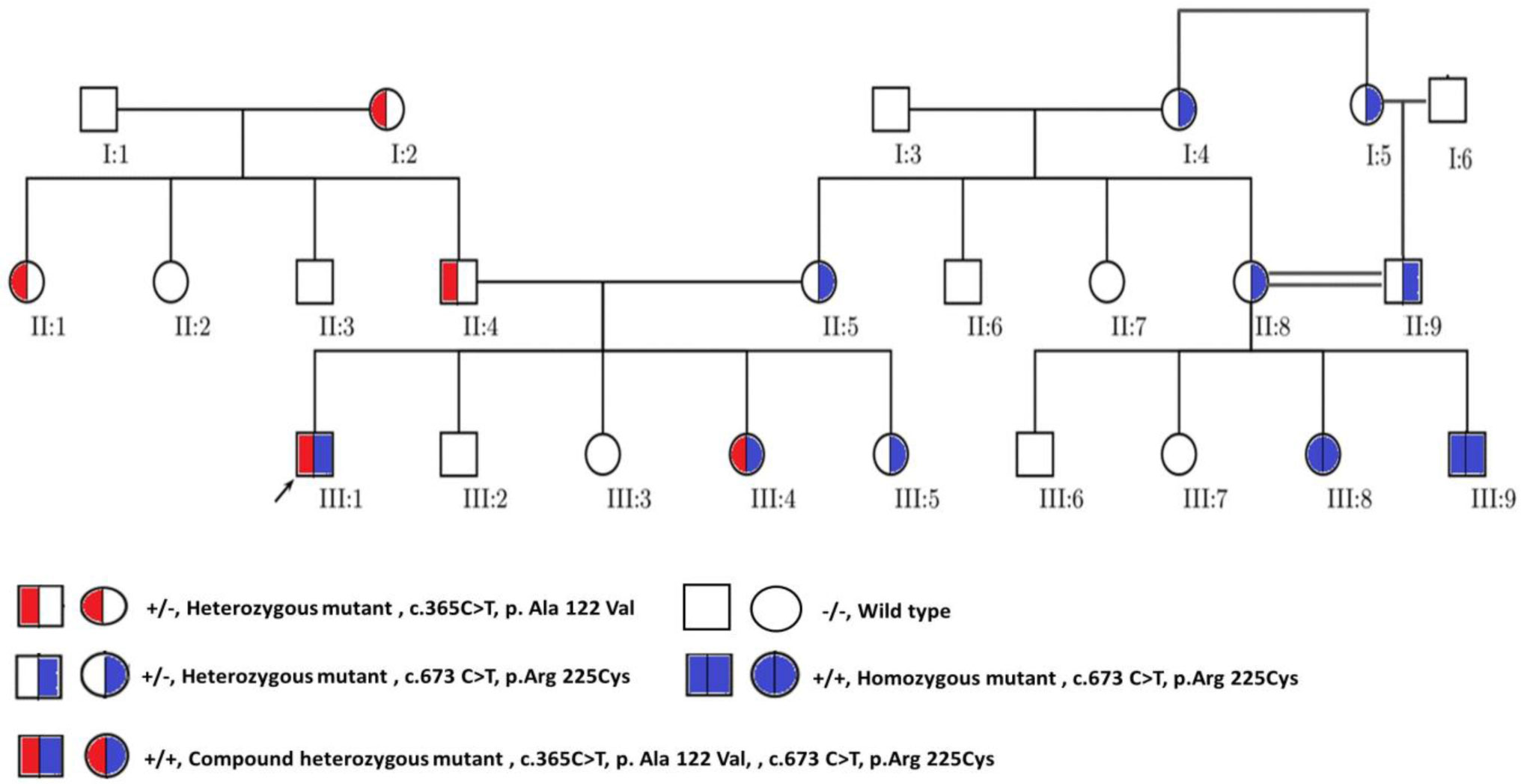









 DownLoad:
DownLoad:
